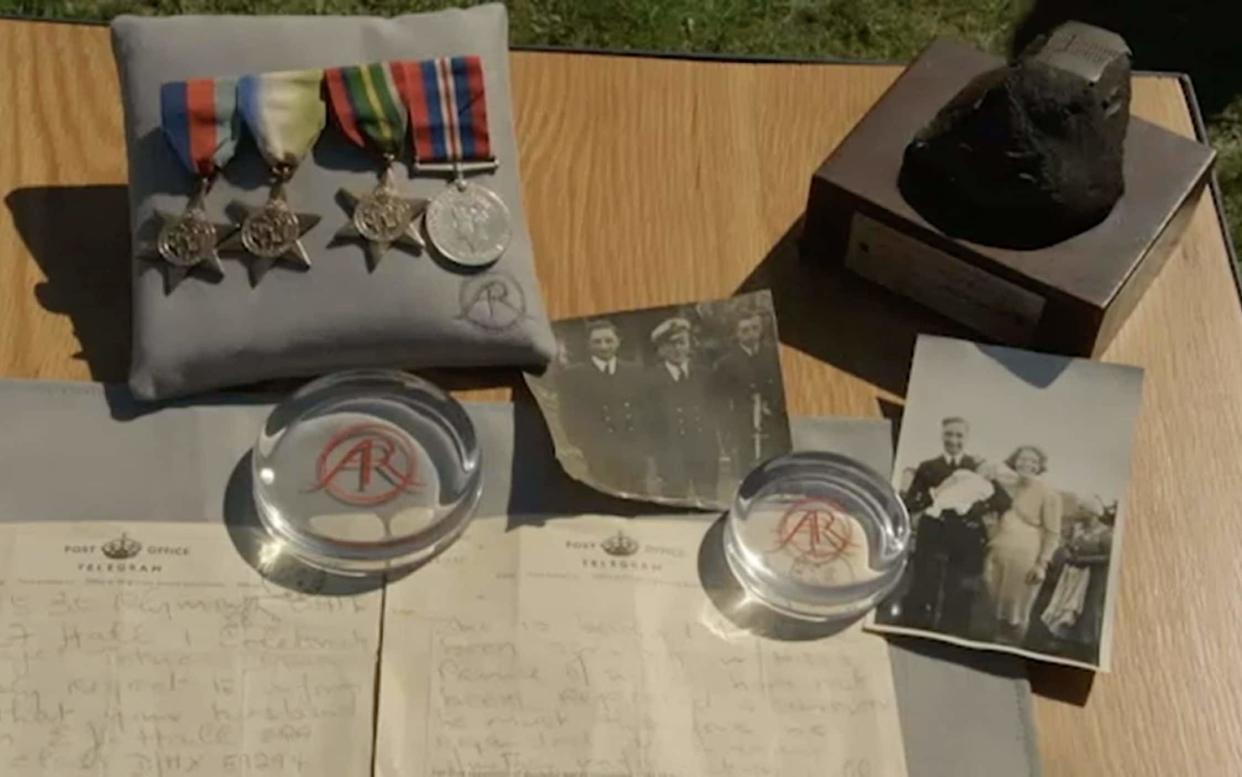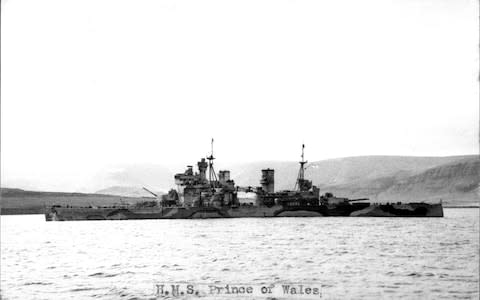Fragment of Bismarck shell that struck Prince of Wales donated to UK's newest aircraft carrier

As he collected the fragment of shrapnel that had just blasted through the hull of HMS Prince of Wales, seaman Gordon Hall could not have imagined the lump of metal, fired from the Bismarck, would one day be valued at £1,000.
The deadly reminder of Germany’s greatest Second World War battleship and one of the most famous naval battles of the war, has just been donated by Brenda Benham, Mr Hall’s daughter, to Britain’s newest aircraft carrier and namesake of her father’s ship.
Brenda’s father had been a mechanic on HMS Prince of Wales when she was involved in the encounter with the Bismarck at the Battle of the Denmark Strait on May 24, 1941.
The Prince of Wales was badly damaged in the fight and pieces of shrapnel from a huge Bismarck shell had smashed into the engine room deep in the bowels of the ship where Gordon was working. The vessel managed to limp to Rosyth for repairs.
However, the battlecruiser HMS Hood, pride of the Royal Navy, was destroyed in the battle and sank in less than four minutes. All but three of the 1,418 seamen on board were drowned.

The destruction of HMS Hood spurred a relentless pursuit by the Royal Navy involving dozens of warships.
Two days later heading for occupied France for repairs, Bismarck was attacked by 16 biplane torpedo bombers from the aircraft carrier HMS Ark Royal.
One scored a hit that rendered the battleship's steering gear inoperable and in her final battle the following morning the already crippled Bismarck was severely damaged during a sustained engagement with two British battleships and two heavy cruisers.
She was eventually scuttled by her crew and sank with a heavy loss of life.

Gordon had taken the shell fragment from Bismarck home with him to Totnes, Devon, when he was given a week's leave in 1941 to visit his wife, Elizabeth, and two-month-old daughter Brenda.
It was the first and last time Brenda ever saw her father.
Gordon returned to HMS Prince of Wales which then headed to Japan as the flagship of Force Z, the British naval squadron that also consisted of HMS Repulse and accompanying destroyers.
Only six months after seeing his infant daughter, Force Z came under attack by Japanese aircraft and HMS Prince of Wales sank with 372 fatalities, including Brenda's father. She was just eight months old.
"When the Prince of Wales was in dry dock in Rosyth, my father had the Bismarck shrapnel mounted on a piece of wood," Brenda said.
She recalled how the block, measuring around four square inches with the inscription ‘fragment of shell fired from German battleship Bismarck in action against HMS Prince of Wales May 24th 1941’, had sat on her mother’s desk for as long as she could remember.
"She died and I had it but nobody in my family is interested in looking after it now,” she said.
"I'm coming up towards 80 and I felt I had to make a decision.
"I didn't want it shoved into the back of the garage or up in the attic so I offered it to the new Prince of Wales ship and they said 'yes please' to it."

Before giving the shrapnel to the Navy, Brenda took it to the BBC's Antiques Roadshow when it was filming at Buckfast Abbey last year.
She was filmed showing the shrapnel, mounted on a small wooden plinth, her father’s medals and the telegram relaying his loss, to military specialist Mark Smith.
Brenda explained: "He said he hadn't seen a bit of the shrapnel from Bismarck before and he was very interested in it.
"He valued it at between £600 and £1,000 but it's not about the money it's a bit of history and there aren't many bits of shrapnel from what was Germany's biggest battleship at that time."
Brenda has kept hold of her late father's medals, letters, photographs and the telegram informing her mother that her husband was "missing presumed dead".

The telegram to Brenda’s mother stated: ‘Deeply regret to inform you that your husband Gordon E J Hall who is believed to have been serving on HMS Prince of Wales has not been reported as a survivor. He must therefore be regarded as missing’.
Brenda donated the mounted shrapnel to Captain Steve Moorhouse, the former commanding officer of HMS Prince of Wales, who invited her to Rosyth to visit the new aircraft carrier that carries the name of her father’s ship.
"They are going to put it in the ship somewhere on display, with a write-up about it and my dad where the ship's company can see it."
HMS Prince of Wales, sister ship to HMS Queen Elizabeth, is due for commissioning later this year.
Want the best of The Telegraph direct to your email and WhatsApp? Sign up to our free twice-daily Front Page newsletter and new audio briefings.

 Yahoo News
Yahoo News 
